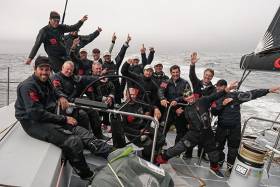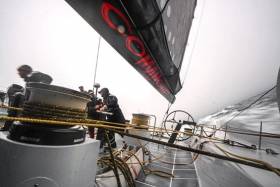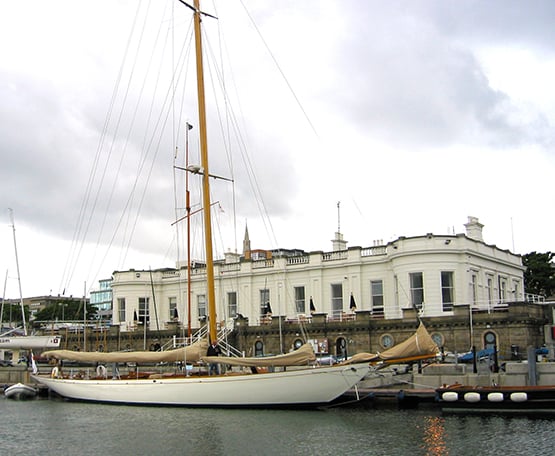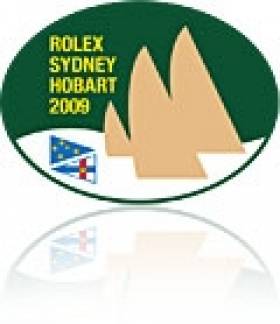Displaying items by tag: Comanche
No Slowing Down for Cork Supercrew Justin Slattery as Newport Bermuda Race Kicks Off Packed Calendar for Second Half of 2022
2022 has been a busy year so far for Ireland’s top offshore racer Justin Slattery — and it’s not slowing down anytime soon.
While the double Volvo Ocean Race champion crewman won’t be taking part in this weekend’s Round Ireland Race, that’s only because he’s starting the Newport Bermuda Race later this week (follow the race tracker when it gets under way this Friday 17 June).
As regular Afloat readers know, the Cork man was on Rán when it won the UK IRC Nationals on the Solent this past weekend.
 Smiles all round for the team on Niklas Zennström's Carkeek FAST40+ Rán (including Ireland's Justin Slattery, fourth from left) after winning the 2022 IRC National Championship + class victory in IRC One Photo: Rick Tomlinson
Smiles all round for the team on Niklas Zennström's Carkeek FAST40+ Rán (including Ireland's Justin Slattery, fourth from left) after winning the 2022 IRC National Championship + class victory in IRC One Photo: Rick Tomlinson
It was just the latest in a series of stellar results that started in January with victory — and a new record — in the RORC Transatlantic Race with the super-maxi Comanche.
The following month, Comanche with Slattery on deck came second overall in the Caribbean 600.
Staying in the West Indies, he joined the crew of the world’s largest carbon composite sailing yacht, Hetairos, setting a new monohull record in early March’s Round Antigua Race and defending the St Barths Bucket title a few weeks later.
 Comanche won the IMA Trophy and set a new race record after arriving in Grenada in record time | Credit: James Mitchell/RORC
Comanche won the IMA Trophy and set a new race record after arriving in Grenada in record time | Credit: James Mitchell/RORC
Crossing the Atlantic, Slattery was part of the winning crew of the WallyCento yacht Galateia at Mallorca’s PalmaVela regatta last month — and more recently was back on Rán, Niklas Zennström’s FAST40+, as it dominated the fleet at the RORC Vice Admiral’s Cup.
Slattery’s calendar for the rest of 2022 looks just as packed. Following the Newport Bermuda Race, he returns to Palma at the end of June for the Superyacht Cup to compete on the J Class entry Ranger.
He’ll be on board Rán Racing’s TP52 for the Channel Race in July, as well as the Rolex Middle Sea Race in October.
August brings Hamilton Island Race Week, where he’ll join the crew of Andoo — the new name of the 100-footer Comanche. Andoo is also scheduled for the year-ending Rolex Sydney Hobart Yacht Race.
And in September he’s back in the Mediterranean on Galateia for both the Maxi Yacht Rolex Cup at Porto Cervo, Sardinia and Les Voile de St Tropez in early October.
With his performances so far and an epic rest of the year lined up, January’s Sailor of the Month (International) will surely be a regular feature on these (web) pages over the months to come.
Comanche Sets "Unbeatable" Middle Sea Race Monohull Record
In one of the most superb high speed offshore racing competitions, three of the world's largest and fastest racing maxis yesterday morning arrived back in Valletta, first monohulls home in the Rolex Middle Sea Race, first event of the International Maxi Association's 2021-22 Mediterranean Maxi Offshore Challenge.
They covered the race's 600-mile anti-clockwise lap of Sicily at record pace.
In 2007 American George David and his original Rambler 90 had established the benchmark Rolex Middle Sea Race record time of 47 hours, 55 minutes and 3 seconds. Despite numerous attempts in his subsequent Rambler 100 and Rambler 88, the tenacious David never managed to improve upon his time in the intervening years.
Since the Royal Malta Yacht Club's classic 600 miler started on Saturday there has been a prolonged battle for the monohull lead between the line honours favourites, the tried and tested, now Russian-owned, VPLP-Verdier 100 Comanche and Dmitry Rybolovlev's ClubSwan 125 Skorpios, only launched at Nautor's yard in Finland late this spring. After a close race, it was Comanche that prevailed, crossing the finish line at the entrance to Malta's Marsamxett Harbour at 04:27:50 yesterday morning in an elapsed time of 40 hours, 17 minutes and 50 seconds. This represented a monumental improvement over the previous record of a 7 hours 37 minutes and 13 seconds or 16%.
Skorpios finished 1 hour 26 minutes astern while Rambler 88, outgunned by the sheer waterline length advantage of her rivals finished mid-morning. With an elapsed time of 46 hours 20 minutes and 25 seconds David bettered his 2007 time and under IRC Rambler 88's elapsed time corrected out to 3 hours 20 minutes ahead of Skorpios, but short of Comanche.
Behind the lead trio this evening a second wave of maxis were having a harder time of it, past Lampedusa and on the home straight back to Malta, but in headwinds. This group included the Gašper Vinčec-skippered 100ft Way of Life and several VO70s and VO65s led by the Grzegorz Baranowski skippered VO70 I Love Poland (ex-Puma). Marton Jozsa's Reichel/Pugh 60 Wild Joe was just past Lampedusa.
The 2021-22 IMA Mediterranean Maxi Offshore Challenge continues next year with the Regata dei Tre Golfi, 151 Miglia-Trofio Cetilar, Rolex Giraglia and the Palermo-Montecarlo.
Comanche Breaks Monohull Transatlantic Record
At 12:19:41s GMT today, Thursday 28th July, Comanche passed Lizard Point (UK) to complete the 2,880 nautical miles from West to East across the Atlantic and smashed the monohull transatlantic record*. This illustrious record had been held by Mari Cha IV since 2003 and stood at 6 days 17 hours 52 minutes and 39 seconds. The talented crew of world class sailors beat the previous record by 1 day, 3 hours 31 minutes 14 seconds in a total elapsed time of 5 days, 14 hours, 21 minutes 25 seconds at an average speed of 21.44 knots.
Comanche’s owner Jim Clark said: “Comanche was built to break ocean records and the guys have once again powered our fantastic fat-bottomed girl to another title. I am so proud of the entire team and everyone involved in the entire program from top to bottom, the best in world, getting the best out of Comanche. Perfect harmony, and Kristy and I are over the moon.”
The experienced team left New York (USA) on Friday evening July 22nd at 20:58 UTC and headed East aiming for the South West tip of England.
Comanche had been on standby for a number of weeks waiting for optimum conditions to slingshot across the Atlantic, managing a fluid rota of over 30 world class sailors on standby over a three month period, primed to be ready at a moment’s notice. On Thursday the team were moved to a ‘green’ as world class navigator Stan Honey alongside skipper Ken Read, agreed that this was the time to go.
With Comanche skipper Ken Read committed to TV commentating at the Louis Vuitton America’s Cup World Series in England, the world class crew was led by team leaders Casey Smith, Tony Mutter, Richard Clarke and Navigator Stan Honey. Due to other commitments, Comanche was also missing regular crewmen such as Kelvin Harrap, Warwick Fluery, Jimmy Spithill and Ryan Godfrey (see full crew list below).
Ken Read concluded: “This latest record is testament to Jim and Kristy’s vision. This is the culmination of six years of hard work and a huge team of experts offshore and onshore all working as one. I never had any doubt this crew would deliver the goods – the boat was in perfect condition and the only thing that would scupper the record would be Mother Nature. Luckily she didn’t throw a spanner in the works and this team have once again proven why they are some of the best in the business.”
The weather window promised fast conditions with strong winds, great angles and flat seas all the way to Europe. And overall it delivered, enabling the team to tear across the Atlantic in record time, using only manual powered winches and hydraulics. But it wasn’t all plain sailing, the crew encountered some cold, foggy and squally weather with some nail biting lighter patches that kept them all guessing and hoping that they could stay in the same weather system for the duration of the crossing. They also encountered the danger of ice ensuring the team remained on high alert making the trip, and the record, even more of an achievement. Stan Honey used all his experience to identify this unique weather window, once again showing his colours as the best navigator in offshore racing.
Quotes from the boat:
Casey Smith: "What a boat! Now we have got the 24 hours record, the Sydney Hobart, and now the transatlantic. What a boat! Awesome!"
Stan Honey: "There are only about two weather windows a year where a monohull can make it all the way across the Atlantic in one system, and we found one of them. Beating this record by more than a day is above my expectations and I am delighted."
Tony Mutter: "To achieve something like that, it is important to be fast and reliable. I am happy for all the people involved in this project from the very beginning up to now."
Richard Clarke: "Delighted. Awesome trip, I have been loving every minute of it. Now I am proud of the accomplishment for the boat and for the team."
Pablo Arrarte: "I think this is something big. I don’t think anyone will beat it in the near future."
Shannon Falcone: "This was sort of the Everest of the whole Comanche program, and I am both proud and delighted to be part of it."
The record continues to illustrate Comanche’s pedigree since the Supermaxi was launched in October 2013. Comanche has taken line honors in all races but one entered and currently holds four ocean records.
*Record still to be ratified by the WSSC (World Speed Sailing Council)
Comanche Due to Finish Transatlantic Record Attempt Today
Comanche, the offshore record-breaking 100–ft yacht owned by Jim Clark and Kristy Hinze-Clark, looks set to conclude their transatlantic record bid at Lizard Point (UK) on Thursday July 28. The latest ETA puts the Supermaxi at the finish point around 12 PM UTC (1 PM BST), which would see the experienced crew secure another major ocean record.
The boat is sailed with only 17 crew and with all manual powered winches and hydraulics for this record attempt:
Casey Smith (AUS), Boat Captain
Stan Honey (USA), Navigator
Tony Mutter (NZL), Trimmer
Dirk de Ridder (NED), Main Trim
Chris Maxted (AUS), Boat Crew
Jon von Schwarz (USA), Grinder
Juggy Clougher (AUS), Bow
Julien Cressant (FRA), Pit
Nick Dana (USA), Bow
Pablo Arrarte (ESP), Runners
Pepe Ribes (ESP), Bow
Peter van Niekerk (NED), Trimmer
Phil Harmer (AUS), Grinder
Richard Clarke (CAN), Runners
Robert Greenhalgh (GBR), Main Trim
Shannon Falcone (ATG), Grinder
Yann Riou (FRA), Media
Sailing's Best Christmas Panto Is Sydney-Hobart Race
As anticipated here a week ago, the annual 629-mile Rolex Sydney Hobart Race kept offshore racing and nautical entertainment addicts all around the world enthralled through the Christmas period. And it has produced a story to suit almost all tastes. The crowded windward start in Sydney Harbour was exciting – too exciting for some. Then out in the Tasman Sea there was an on-the-nose gale, as expected. There were calms towards the end, as seems inevitable. And the big beamy 100ft American girl Comanche (Jim & Kristy Hinze Clark skippered by Kenny Read) finally got her coveted line honours win.
The hotly-sailed TP 52 Balance, owned and skippered by Australian financial guru Paul Clitheroe, took the Holy Grail (aka the Tattersall’s Cup) for the overall IRC win. And second place went to Fastnet Race 2015 overall winner Gery Trentesaux with one of the all-conquering JPK 10.80s. But the Trentesaux silver medal was only won by a whisker ahead of the restored veteran S&S 34 Quikpoint Azzurro (Shane Kearns).
In all, it has been quite a story, though admittedly Irish hopes were disappointed in that Gordon Maguire, reckoned to be among the Tattersall’s contenders at mid race aboard Matt Allen’s Carkeek 60 Ichi Ban, had to be content with eighth overall on IRC at the finish. But he was second in IRC Div 0, and sixth in line honours. As for the new Mark Mills-designed 45ft Concubine (Jason Ward), she was right in the middle of the rating range which did least well, but still managed a sixth in Division 1. W M Nixon casts an eye over a vintage staging of a great race.
We’re tempted to introduce a new acronym in reporting – IANMTU. But as such a word probably couldn’t exist in any language, we’ll make it IANTU so long as everyone understands that it means: I Am Not Making This Up. And it will have to do, as there was IANTU rampant before the Hobart fleet had even got out past Sydney Heads.
Things were potentially sticky as the forecast north to northeast breeze for the first day of the race actually had much less east in it than expected, making it a tight-packed beat out of an already crowded harbour.
But it’s one very major highly-publicised event. So instead of using their trusty old workhorse of a regular committee boat, the organising Cruising Yacht Club of Australia planned to fire the starting signal cannons from a class of a superyacht appropriate to the presence of celebrities and sponsors aboard to honour this premier sailing event of the Australian yachting calendar. And IANTU, but didn’t the superyacht start taking on water as the countdown began? And she took on water with such superyacht-style speed that the great and the good on board had to be hastily landed two miles up the harbour at a pier called (IANTU) Zoo Wharf.
Fortunately the club’s trusty workhorse committee boat was out and ready to take over starting duties. But there wasn’t time to transfer the official starting cannons from the immersing superyacht which was looking sleeker by the minute up at Zoo Wharf. However, the regular boat did have a horn of sorts, so the 71st Rolex Sydney-Hobart Race started not with a bang, but a toot, which we’ll suppose was a sort of nautical whimper.
It very soon became a proper start to a great race nevertheless, but getting out of the harbour was a bit of a melee, and of course with a fleet which included an unprecedented visiting 26 nations, wasn’t it one of the highest profile visitors – the Chinese TP 52 Ark323 whose tyro crew has already sailed thousands of often rugged miles just to be there – which came out on the wrong side of some shunting among the group of TP 52s and similarly-sized craft, and was so damaged that she had to retire before getting to the open sea?
Later in Hobart, it was adjudged that another TP 52 was at fault. This was the famous Syd Fischer’s Ragamuffin 52, which was being raced by his grandson Brenton, as Syd himself – now aged 88 – was racing aboard his super maxi Ragamaffin 100. That gives you some insight into the depth of involvement the great Australian sailing families have with the annual Hobart thrash. But the fact that the grandson and his crew were penalized, after an otherwise quite good race, was scant consolation for the Chinese crew, who saw more than a year of effort and intense training go straight down the tubes in one short sharp incident.
There was nothing at all amusing in it. But before the fleet had cleared the harbour with one or two other less damaging scrapes, there was entertainment on the sidelines among the spectator fleet. There, a little old motorboat – definitely not a superyacht – decided to emulate the official start boat by leaking so much that her doughty skipper with his motley crew headed pronto for the nearest beach which (IANTU) happened to be a popular nudist bathing venue. The resulting much-photographed scenes of some rescuers in the nip led to the 71st Rolex Sydney-Hobart Race getting more publicity in the worldwide popular press than it has done since the tragic events of the ultra-stormy race of 1998.

It could only be Sydney Harbour. One of the spectator boats found she was sinking off a nudist beach.
But meanwhile there was a proper serious race taking shape. In the short sharp beat to the harbour mouth, amongst the maxis Anthony Bell in command of his hundred foot Perpetual Loyal (ex Rambler 100) found himself in a minority of one by holding to the starboard side in the rising breeze, but he’d made the right call. Perpetual was at the harbour-exiting turning mark clear ahead - but only just. Comanche and the much-altered Wild Oats XI were right behind her, and out in open water with plenty of breeze and freed sheets, Comanche simply became a different sort of animal altogether. She roared away into the lead, while among those trying to hang onto her coat-tails, it was notable that George David’s smaller Rambler 88 was punching way above her weight - she was dealing with the Tasman Sea’s rough and irregular waves as though she was sailing in smooth water.
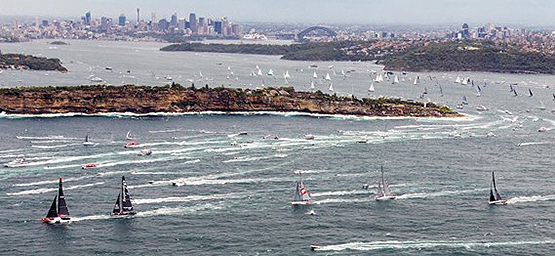 Clear the way…..having reached open water, Comanche is seen here streaking away from Perpetual Loyal, Wild Oats XI, Ragamuffin 100, and Rambler 88. Photo: Rolex
Clear the way…..having reached open water, Comanche is seen here streaking away from Perpetual Loyal, Wild Oats XI, Ragamuffin 100, and Rambler 88. Photo: Rolex
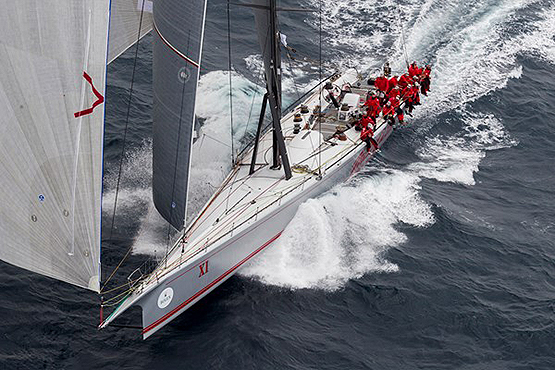 When the going was good……the new-look extra-skinny Wild Oats XI making knots on Day 1 when the wind was fair. But that night’s Southerly Buster shredded her mainsail, and she retired. Photo: Rolex
When the going was good……the new-look extra-skinny Wild Oats XI making knots on Day 1 when the wind was fair. But that night’s Southerly Buster shredded her mainsail, and she retired. Photo: Rolex
This was all splendid mile-eating stuff while it lasted, tearing along on port with every stitch set and water flying all over the place. But everyone knew only too well that the first night would bring a classic Southerly Buster, gusting to 45 knots bang on the nose.
The underlying south-going stream was in fine form, so this would inevitably create horrendous wind-over-tide conditions when the new wind arrived. Except that a regular tidal cycle changes every six hours. The worst of normal wind-over-tide conditions will last only 4 to 5 hours. But this south-going stream continues regardless of the local state of the tide. Thus everyone prayed that the front at the heart of the Southerly Buster would go through in a reasonable time. It didn’t. The ferocious slugging match lasted around 18 hours. It was boat-breaking, gear-wrecking, crew-bashing stuff.
The litany of damage was comprehensive. The remarkable thing is that only 30 boats felt they’d no option but to pull out. The highest profile exit was by Wild Oats XI. The sudden nature of the change in conditions is indicated by the fact that as night drew on, one of the most experienced crews in the race were so suddenly hit by a squall of 40 knots-plus, and from the opposite direction to the day’s wind, that by the time they’d got things back under some sort of control, their mainsail was torn beyond all use and repair, and Wild Oats XI soon retired.
 By heading south the Sydney-Hobart course takes the fleet into ever more rugged waters
By heading south the Sydney-Hobart course takes the fleet into ever more rugged waters
Ragamuffin 100 was likewise taken totally aback, but though she lay completely on her ear over to port with the canting keel deployed in the totally wrong direction for fifteen minutes, somehow they got it all back together again with the mainsail still intact and nobody lost over the side, though some of them had spent rather longer in the Tasman Sea than they might have wished. Their troubles weren’t over, as they soon broke off a daggerboard. But they managed to get it clear and drilled a hole in the foot of the other daggerboard to take a line so that they could haul it up again when it was needed to move it to the other side.
Meanwhile Perpetual Loyal “sailed fast straight off a cliff”, and landed with such a bang that she sustained sufficient hull damage to make urgent retirement a necessity while she could still look after herself. Rambler 88 also had damage to both daggerboard and rudder, yet reckoned she still had enough bits hanging on to get to the finish with a bit of nursing. However, up ahead Comanche had sustained so much damage to a daggerboard and rudder she was for a while officially recorded as being retired. But then Kenny Read and his crew took another look at it and decided that as they’d come so far to do the race, and as it wasn’t that far to Hobart, they’d limp along to the finish somehow or other, though any chance of a record was out of the question.
With the fleet order taking shape, special interest focused on the Carkeek 60 Ichi Ban and Rupert Henry’s Judel Vrolik 62 Chinese Whisper, as the pundits reckoned this was the boat size best suited to the forecast pattern of wind conditions. Indeed, so firmly had this prediction become that Matt Allen – having kept his options open by also having an entry in for his TP52 Ichi Ban I – chose between his two boats by going for the Carkeek, with the TP 52 staying behind in dock.
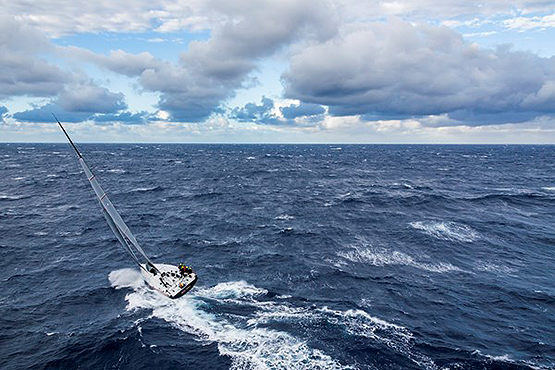 A long way to go, and a lot of southerly wind to get through – Ichi Ban slugs it out in open water. Photo: Rolex
A long way to go, and a lot of southerly wind to get through – Ichi Ban slugs it out in open water. Photo: Rolex
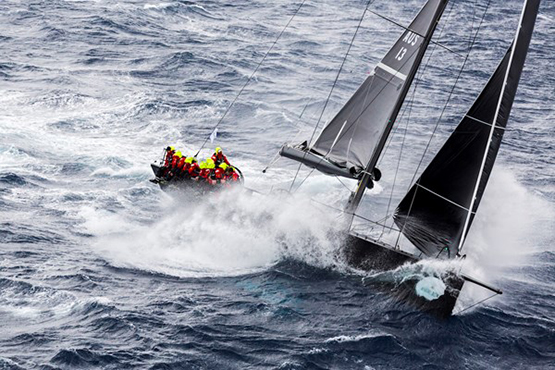
The low-freeboard JV 62 Chinese Whisper was originally the successful day racer Spirit of Jethou, but she seemed to cope more than reasonably well with rugged offshore stuff. Photo: Rolex
The irony of this decision in light of the final overall result cannot be denied. But it should be pointed out that though the TP 52 Balance won overall, of seven TP 52s starting, only three finished, the other being the penalized Ragamuffin 52, with the third one Damien Parkes’ Duende aboard which Tony Cable was doing his 50th Sydney-Hobart Race. So who knows whether Ichi Ban I would have made it, whereas the hefty Carkeek 60 came through with style.
But as has been remarked before, maybe the 60ft Ichi Ban is just a bit too hefty. Certainly she is markedly different from Chinese Whisper, which in the end beat the Allen-Maguire team by an hour and nine minutes. The Whisper is one interesting boat. Originally she was Spirit of Jethou, designed in 2009 by Judel Vrolik and built by Green Marine to be a 60ft day racer – hence her low freeboard - for Peter Ogden. In 2012, with input from Brad Butterworth, she was lengthened by two feet and optimised for the Mediterranean circuit, in which she swept all before her.

The TP 52 Duende (Damian Parkes) placed 7th in the PHS Division, while it was the 50th Sydney-Hobart Race for crewman Tony Cable. Photo: Rolex
That this “inshore racer” has now won her class in the toughest Sydney-Hobart race since 2004 speaks volumes for her basic qualities. And though she has become 2ft longer than Ichi Ban, somehow she manages to rate 1.489 to Ichi Ban’s 1.501. That tiny margin makes for a huge difference when the two boats are racing neck-and-neck for much of the course, and particularly when, in the latter half of the race, Chinese Whisper tended to be always around a mile nearer the finish.
As for the eventual overall winner Balance, while she may have started with the prospect of boat-for-boat racing against other TP 52s, by the finish she was very much alone, but fortune was with her, and she’d a splendid sail in a private breeze making 16 knots and better for the final approaches to the Derwent and the tricky last few miles to the Hobart waterfront.
Even once she was in, so many other boats were still out racing with a good chance to beat her on corrected time that crew members who hadn’t signed up to sail the boat back to Sydney flew back home to spend the last of Christmas with their families. But within a couple of days, their skipper was on the phone to get them to fly south again for the prize-giving, as they’d won the Tattersall’s Cup.
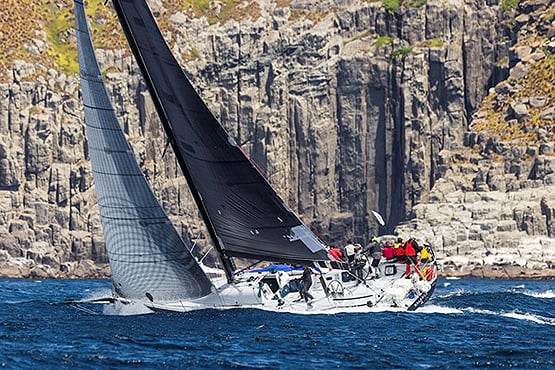
Overall winner Balance with her much-repaired mansail finds smoother water in under the Tasmanian coast. Photo:Rolex
It had seemed a long wait for a boat which, as Quest, had been overall winner of the 2008 race. At first Skipper Clitheroe could only give out about the sheer roughness of the sail, and wonder why he did this sort of thing at all, and how his crew had miraculously kept his very damaged mainsail in one piece “using every last bit of stickyback on board”.
But then as each challenger failed to make the necessary finishing time, Balance’s position looked firmer than ever. The Reichel Pugh 51 Primitive Cool (John Newbold) was a contender, but missed. For a long time, Eric de Turckheim’s Archambault 13 Teasing Machine from France looked very good indeed, but she too missed the slot. Then for some giddy hours the great Gery Trentesaux, overall winner of the Rolex Fastnet Race 2015, looked as though he might complete an astonishing double, but he too fell short.
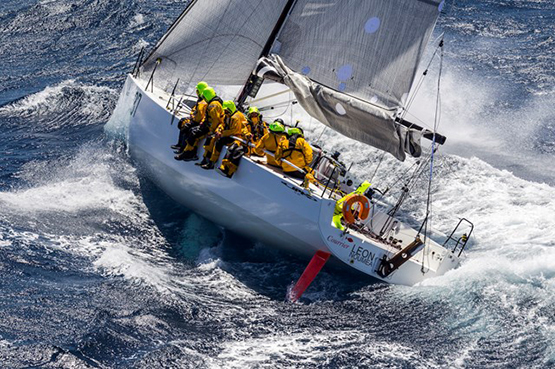
Good in all conditions – Gery Trentesaux, overall winner of the Rolex Fastnet Race in August, on his way to second place overall in the Rolex Sydney-Hobart Race in Courrier Leon. Photo: Rolex
So then as the clock ticked on, the only boat left to push Balance off her perch was the veteran S&S 34 Quikpoint Azzurro (Shaun Kearns), by which time the story was writing itself. Paul Clitheroe is, among other things, a financial guru with a TV programme on money management, while Shane Kearns broke all the rules on prudent money management by buying an old semi-derelict S&S 34 with his credit card, and then splashing out further with the plastic by optimising the boat such that with her Australian coachroof and bowsprit, you’d be hard put at first to guess this was an S&S 34 whose design dates from 1969.
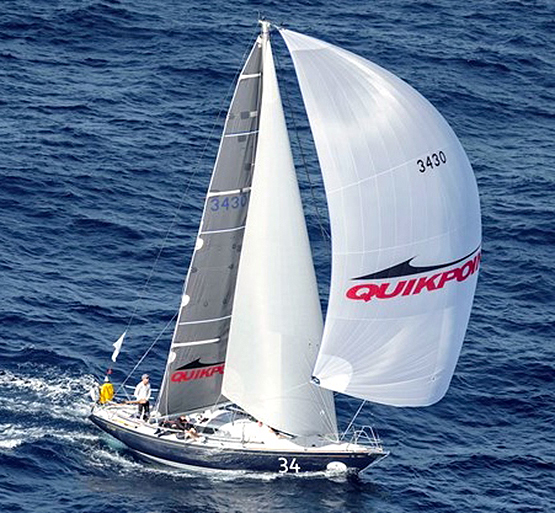 Little old boat that nearly made the top title. The beautifully-restored veteran S&S 34 Quikpoint Azzura (Shane Kearns) for some hours looked like being the overall winer but the flukey winds of the Derwent saw her slipping and she placed third, just six minutes behind second-placed Courrier Leon. Photo: Rolex
Little old boat that nearly made the top title. The beautifully-restored veteran S&S 34 Quikpoint Azzura (Shane Kearns) for some hours looked like being the overall winer but the flukey winds of the Derwent saw her slipping and she placed third, just six minutes behind second-placed Courrier Leon. Photo: Rolex
Yet even Quikpoint Azzurra, rating way down at 0.926, failed to make it. Indeed, so excruciatingly slow were her final miles that she finally lodged in third overall behind Gery Trentesaux, who was sailing a sister-ship of the boat with which he won the Fastnet, This was a JPK 10.80 which happened to be cruising the Pacific, but was re-routed to Sydney for the Trentesaux team to turn up with a new suit of sails, including a specially reinforced mainsail.
That special mainsail proved to be one of the veteran skipper’s best decisions - and he has made many good ones. And we now also know that all the questions after the 2015 Fastnet win, wondering just how good the incredibly successful JPK 10.80 design would be in a real breeze of wind, have been very satisfactorily answered out in the rough Tasman Sea.
The corrected times of the top ten boats in the Rolex Sydney-Hobart Race 2015 say everything about the remarkable diversity of the fleet. And the IRC has given a reasonably good account of itself, with just 52 minutes covering the seven boats between 2nd and 7th in a difficult race.
Rolex Sydney-Hobart Race 2015 IRC Overall:
1st Balance (2008 TP 52, Paul Clitheroe, NSW) CT 04:07:27:13;
2nd Courrier Leon (2013 JPK 10.80, Gery Trentesaux, France) 04:10:02:53;
3rd Quikpoint Aazzura (1973 S&S 34, Shane Kearns, NSW) 04:10:09:01;
4th Primitive Cool (2010 Reichel Pugh 51, John Newbold, Victoria) 04:10:36:19;
5th Chinese Whisper (2009/2012 Judel Vrolik 62, Rupert Henry NSW) 04:11:39:18;
6th Wild Rose (1987 Farr 43, Roger Hickman, NSW) 04:11:41:53;
7th Teasing Machine (Archambault 13, Eric de Turckheim, France) 04:11:54:47;
8th Ichi Ban (2014 Carkeek 60, Matt Allen NSW) 04:12:48:46;
9th Mayfair (2010 Beneteau First 40, James Irvine, Queensland) 04:14:29:56;
10th Imagination (2004 Beneteau First 47.7, Robin Hawthorne, NSW) 04:14:58:17.
America's Comanche Sails to Victory in Hobart
Jim Clark and Kristy Hinze-Clark’s super maxi Comanche pulled off an incredible feat tonight, taking line honours in the 71st edition of the Rolex Sydney Hobart Yacht Race, winning the Illingsworth trophy and a Rolex Yacht Master II timepiece. This was the first time in 17 years that the most coveted title in offshore yacht racing has been won by an American team since Larry Ellison’s Sayonara won in 1998.
Designed to break records, the 100 foot maxi debuted in last year’s edition of the Rolex Sydney Hobart and since then has circled the globe, collecting the most prestigious titles in yachting – setting a new 24 hour monohull distance record, line honours in the New York Yacht Club Transatlantic Race and the Rolex Fastnet Race – Comanche’s performance this past year has been unlike anything ever seen in yacht racing. Returning to Australia, seeking the title that they so narrowly missed out on last year, was a Herculean effort, which has paid off nicely.
Despite facing retirement after having suffered significant damage (to a dagger board and rudder) on the first night, skipper Ken Read made the game-changing call to effect repairs and finish the race, saying: “I don’t care if we limp over the line!”
A true test of stamina and determination, the international crew of 21 included co-owner Kristy Hinze-Clark and fellow Australian, America’s Cup winner Jimmy Spithill. Commenting on her first Rolex Sydney Hobart, Hinze-Clark described her experience: “It was really gruelling. Pure terror at one stage. Excitement and now just total joy. It's one of the best things I've ever done.”
The French-designed maxi managed to extend their lead this afternoon as they rounded Tasman Island and crossed Storm Bay towards the finish line, putting solid distance between fellow American competitor George David’s Rambler 88, which is expected to finish in the early Tuesday morning (AEDT). Syd Fischer’s Ragamuffin 100 is in close pursuit despite having severed their starboard dagger board overnight, crashing through the rough seas.
The 2015 edition of the Rolex Sydney Hobart Yacht Race has delivered some of the most grueling race conditions since 2004. Almost one third of the fleet of 108 retired in the first 48 hours – the litany of damage included rudders, dagger boards, masts and sails. The remaining teams have their sights set on the finish line in Hobart in hopes of a win on corrected time.
Most of the smaller yachts have only just passed the halfway mark in Bass Strait and as the breeze continues to lighten towards the Tasman coast the Tattersall's Cup, for overall corrected time winner, is still in play.
Comanche's official finish time for the 2015 Rolex Sydney Hobart Yacht Race was 2 days, 8 hours, 58 minutes and 30 seconds.
The Legendary Start For Sydney’s Headlong Rush To Hobart
There’s nothing that really compares with the annual Rolex Sydney Hobart Race. While most of the more-populated parts of the world in the Northern Hemisphere are in their midwinter shutdown, somnolent and sluglike in a festival of consumer excess, away south of the Equator one of the most magnificent city harbours in the world is exuberantly celebrating outdoors in all its midsummer glory. And then it tops out the party with one of world sailing’s great spectacles. W M Nixon anticipates the Rolex Sydney Hobart Race 2015, which starts in full daylight in Australia an hour after this is posted at midnight on Christmas Day in Ireland.
With the Yuletide festivities scarcely put away, a group of extreme boats at the peak end of the hundred foot size limit - every last one of them owned and sailed by larger-than-life characters – comes roaring out of Sydney’s glorious harbour at the head of a magnificent fleet, a colossally varied collection of 108 craft in which every crew reckons they’re in with a chance. For although line honours for the biggies are what captures the headlines, for the dyed-in-the-wool enthusiasts the only real trophy in the thrash to Hobart is the Tattersall’s Cup for the overall winner on IRC Handicap.
A severe weather forecast of three days ago has now been watered down, but there’ll still be plenty of breeze at some stages to be going along with. The start is expected to be in a moderate to fresh northeasterly, stronger outside once they begin making southing down the Tasman Sea, with most boats chasing that elusive race-winning south-going current which may be anything up to ten miles offshore.
Then everything changes in the weather situation with an active front rolling up from the south and southwest, with strong headwinds – maybe gusting to 45 knots in the front itself – providing atrocious wind-over-tide conditions with the under-lying south-going current. There’ll be a lot of Christmas dinners spread out over the ocean……After that, the winds are forecast to fall away as the bulk of the fleet get to the Bass Strait, but overall the pundits are reckoning boats in the 60ft to 75ft size range are looking to be the favoured cohort, while George David’s Rambler 88 – with the legendary Brad Butterworth in the afterguard – is now looking good to give the hundred footers more than a few tense moments.
By the time you’re likely to be reading this on Saturday morning, the drama will already be unfolding on the other side of the world, and all sorts of newsfeeds will be available for the best armchair offshore racing of the year. Yet as a Rolex Sydney-Hobart Race addict, I’ll readily concede that the last thing addiction provides is a clear picture, so you can expect this anticipation to be something of a rose-tinted view.

The Rolex Sydney-Hobart Race – a classic course which is staging its 71st edition as 2015 draws to a close
But that said, the Rolex Sydney Hobart Race of 2014 will take some beating. It provided the glorious battle for line honours between the new Comanche and the continually-evolving Wild Oats XI, veteran owner and local favourite Bob Oatley’s originally 98ft Reichel Pugh Wild Oats XI of 2005 vintage, but modified almost every year since, such that by December 2014 she was a hundred footer. Against her, the big new fat girl, Jim and Kristy Hinze Clark’s JK-designed total hundred footer Comanche, so big and beamy you could fit two Wild Oats into her and still have room to spare.
Yet although all the heavy metal seemed to be on Comanche’s side, including having the formidable Kenny Read as skipper, in the end the skinny girl wriggled her way through some awkward conditions which Comanche loathed, and wriggled to such good effect that Wild Oats took line honours.

It’s reckoned you’d still have room to spare after fitting two of Wild Oats XI (left) into the very different hull of Comanche (right)
And then, to put the icing well and truly on the Hobart cake, as the various potential handicap winners were knocked out by the remorseless ticking of the clock, an overall winner emerged who was the very epitome of the true Australian ocean racing spirit. The veteran Farr 43 Wild Rose, owned successfully for many years by Roger Hickman, was on top of her immaculate form, and won the Tattersall’s Cup.
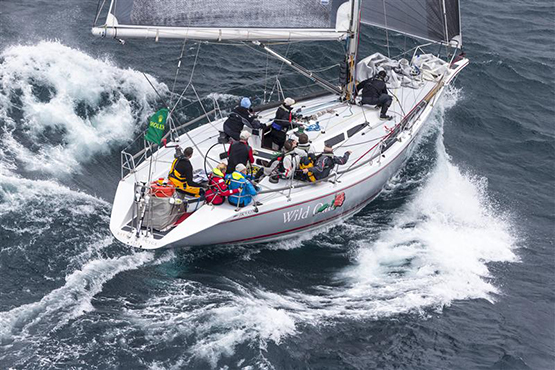
The true spirit of Australian offshore racing – Roger Hickman’s 28 year old Farr 43 Wild Rose (ex-Wild Oats) is defending champion in this year’s Rolex Sydney-Hobart race
And what was Wild Rose’s back-story? You just couldn’t make it up. She was one of the first boats to be called Wild Oats, brought to the Australian racing scene by a legendary entrepreneur called Bob Oatley who’d been so successful in business in Papua New Guinea that at one stage he was controlling 95% of the entire country’s GDP. And then, when local interests bought him out, he shifted operations back home to Australia, and created himself a new conglomerate business empire on an even large stage.
He found that the challenge of campaigning a serious offshore racer at the top end of the exuberant Australian offshore racing scene went perfectly with business. If the boat did well, enterprises like Robert Oatley Wines did well too. But regardless of that, it was fun. So although he’s looking into his 90s. Old Bob is as keen as ever on the whole crazy game, and with Mark Richards he has the perfect skipper/boat manager to maximize returns from the sheer entertainment provided by keeping Wild Oats XI up to the mark to fulfill her role as the people’s favourite.
The improvement project for 2015 was basically to re-position the mast. Now most folks, if they decide the mast is too far forward, they’d simply move it aft. But not the Wild Oats team. At its most fundamental, what they’ve done is keep the mast where it was, but they chopped off the bow - the chainsaw pix say it all - and then added a completely new longer slimmer bow. Try as you might, you can’t see the join…...

If you’re going to take the bow off the boat with a chainsaw, better make sure you’ve the owner there to do it with you. Mark Richards and Bob Oatley start the drastic surgery on Wild Oat XI
 You can’t even see the join….,Wild Oats with her new longer bow (right) with the old bow (left) kept in storage “in case the new one didn’t work” . But would you call that new stem a “clipper bow”?
You can’t even see the join….,Wild Oats with her new longer bow (right) with the old bow (left) kept in storage “in case the new one didn’t work” . But would you call that new stem a “clipper bow”?
Then, to keep her down to a hundred feet, they shortened and re-shaped the stern, such that the result of it all is the skinny girl is now super-slim. But thanks to the latest materials and some ferociously clever engineering and technology, Wild Oats is able to carry a mighty canting keel which keeps this torpedo of a boat upright and powering successfully along, in which mission she is further assisted by all sorts of canards and foils which can be deployed from multiple orifices.
Central to the whole story today, however, is the fact that the Hobart Race 2015 is the first real test of the completely re-vamped Wild Oats XI, and she’s yet again up against Comanche as a trial horse. But after such radical changes, naturally there are those who’ll question them. For a start, it has been noted that with the completely new bow section, the even longer bowsprit on WOXI is receiving additional support from a sort of solid strut from the stem which creates what some of us might describe as a clipper bow.
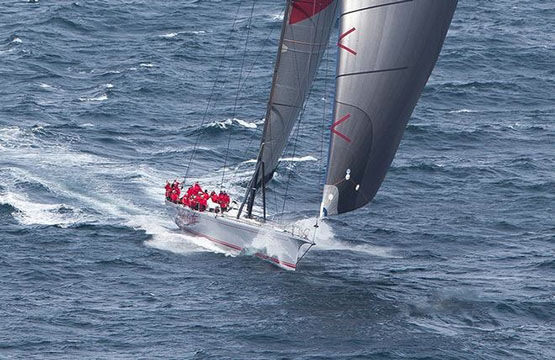
The re-configured Wild Oats XI is faster than ever, but what length is she?
And if you accept that this has indeed become a clipper bow of sorts, instead of a straight stem bow which happens to have a solid strut support for an unusually long bowsprit, then you’re accepting that Wild Oats’ hull has now become more than a hundred feet long, and therefore above the size limit for the Rolex Sydney-Hobart Race. At the time of writing, the Race Committee seemed to have accepted that Wild Oats still has a straight stem. But we can think of a few sea-lawyers who might possibly demur.
In the end, it’s a matter of definitions. Just recently, a Classic Boat magazine profile of the magnificent Fife-designed-and-built 1926 Fastnet Race line honours winner Hallowe’en revealed she is just over 71ft LOA, and something like 47ft when unladen on the waterline. The waterline length was fine, as it allowed some immersion in seagoing trim to stay within the Fastnet limit of 50ft LWL. But what’s with this 71ft plus in the LOA department, when the Fastnet Rule – set after the inaugural race of 1925 – clearly set the upper LOA limit at 70ft? Well, it seems that Hallowe’en is 70ft LOA on deck. And LOD was seen by many as being one and the same thing as LOA back in 1926. So now you know.
Hallowe’en, 1926 Fastnet Race Line Honours Winner, at the Royal Irish YC. While she was 70ft LOD to comply with the Fastnet Race maximum size, her hull LOA is actually slightly north of 71ft. Photo: W M Nixon
Whatever, this morning the one thing we’re starting to know is just how well the new-style Wild Oats is going, as there’s plenty of wind forecast for some stages, and the only test so far against other boats was in smooth water conditions in the Solas Big Boat Challenge a fortnight ago. This was a 14 mile round-the-buoys sprint within Sydney Harbour in which George David’s Rambler 88 was still right there with Wild Oats at the weather mark, but thereafter the Oats lengthened away in impressive style, while the other hundred footers weren’t really in contention with either her or Rambler.

Racing in the Solas Big Boat Challenge on Sydney Harbour a fortnight ago. The new look Wild Oats XI is already showing ahead, but she had quite a job to shake off the smaller Rambler 88 (second right). There’s a lot of sailing history in this photo. Perpetual Loyal (second left) was formerly George David’s Rambler 100 which capsized at the Fastnet Rock in 2011 after snapping off her keel.
But of course Comanche very sensibly stayed away from the Solas Big Boat Chalenge. In-harbour contortions aren’t her thing at all. The big wide boat needs the wide open spaces of the clear ocean and the challenge of the 628 miles to Hobart. So it’s right now that the two monsters in their current form are at each other’s throats for the very first time, like a giant rattlesnake against a huge python. Jurassic Park goes sailing…….
After the hors d’euvre of the line honours battle, we then re-focus on the body of the fleet for the main course, and on the race tracker it’s fascinating to watch as fortunes wax and wane for different groups. But within each group, regardless of how they’re doing within the fleet at large, as the race progresses the group leaders become more clearly defined, but quite why and where it happens is sometimes only discernible in the post-race analysis.
For instance, last year the Dun Laoghaire crew of Barry Hurley and the Rumball brothers were right there on their First 40 with the comparably-rated Wild Rose as they approached the Bass Strait. But then with a couple of twists and turns of fortune Wild Rose got herself into a better rhythm, and there she was – gone – while the Irish crew slipped in the rankings.
The top Irish skipper within class in 2014 was Sean McCarter in the Clipper Division with Derry/Londonderry/Doire - he won the Clippers as they took it in as part of their multi-stage race round the world. The Clippers are there again this year in what is the most international fleet yet seen in the Sydney-Hobart, with a first-time strong mainland Chinese representation, particularly through Ark 323, their TP 52 whose home club is the Noah Sailing Club. If they do well, we can hope to find out how a challenger from the People’s Republic seems to draw so heavily on the Old Testament for the names of boat and club alike.

Will she finally find her true form? The Carkeek 60 Ichi Ban (Matt Allen), raced by Gordon Maguire, is in the size cohort favoured by the pundits to suit the forecast wind and weather.
Our own Gordon Maguire, winner overall in 1991 and 2012, is going again, and again it’s on Matt Allen’s Carkeek 60 Ichi Ban, which has a new rudder and other mods, and has been showing an improvement in form. And we now know that Maguire is going with the Carkeek 60 which is called Ichi Ban. Because you see, Matt Allen happens to have a TP 52 which is also called Ichi Ban, and though the modified Carkeek 60 seemed to have found better form to win the Cabbage Tree Island race at the end of November, even then Allen wouldn’t say which Ichi Ban would do the Hobart Race. But with the wind pattern forecast, it will be the Carkeek, indeed she is now rated one of the favourites if the weather does as the gurus say it will.
Another boat of special Irish interest is the completely new Wicklow-designed Mills 45 Concubine, built in Dubai for South Australian sailor Jason Ward of Adelaide, and only afloat since November 11th. So she has scarcely been sailing seriously for much more than a wet week. But the word is the boat’s potential is enormous. And simply seeing how she performs in this ultimate test tank of modern middle distance offshore racing is going to be top of the interest levels for the next few days.
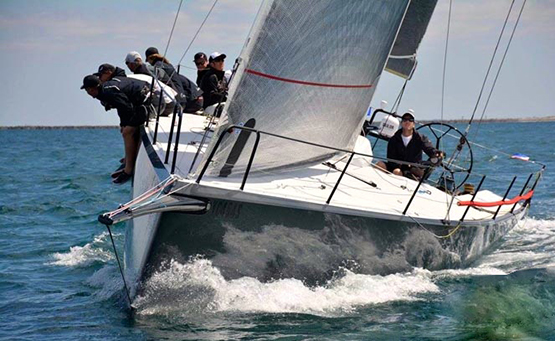
Her lines were drawn in the midst of the Wicklow countryside – the new Mark Mills-designed 45ft Concubine will have her first real test in the Hobart Race
For although the Hobart Race is of rather more recent date than the other classics such as the Bermuda Race and the Fastnet, they are biennial whereas the Sydney-Hobart has been an annual event ever since being founded in 1945, and thus has built up its mystique more quickly. As a result, some devotees log up an astonishing number of races to Hobart, and this year Tony Cable will be doing his 50th . This time round – as it has been for the past four Hobarts – he’s aboard Damien Parkes’ JV52 Duende, but he has been on many different boats, and in all he has raced to Hobart with 308 different crewmates over the years, so they’re going to need a very large premises for his reunion.
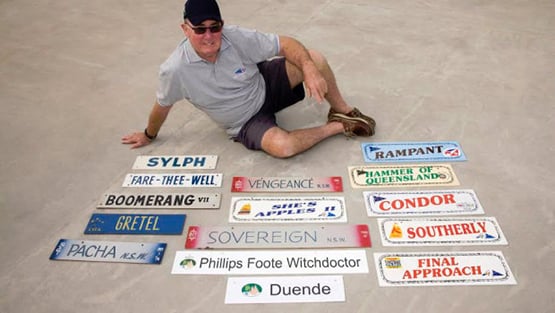
Tony Cable is doing his 50th Sydney-Hobart Race – these are the name plates of the 15 boats he has sailed on
The Sydney-Hobart Race started at the end of World War 2 when Sydney cruising men asked the great offshore racing legend Captain John Illingworth RN – who happened to be running the navy yard at Wooloomoolo at the time – if he’d be interested in a cruise-in-company down to Hobart over Christmas. He said he’d be interested in the offshore passage to Hobart, but only if they made it a race.
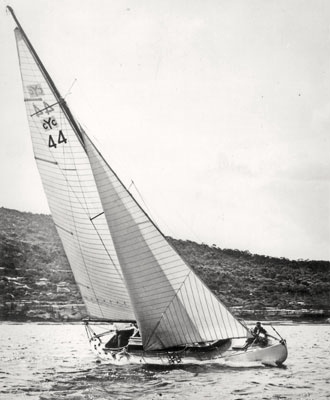
Rani (John Illingworth) was winner of the first Sydney-Hobart race in 1945
By the time it got going, he’d acquired himself a little locally designed and built sloop called Rani. Despite having one of the smallest boats in the fleet, Illingworth battled on through a proper Southerly Buster and then another gale, before he finally got to Hobart expected to be dog last in this new race, as Rani’s radio had packed it in shortly after the start. Thus they’d no word of anyone else at all, while they themselves had been posted missing.
But he found he was twenty hours ahead of the next boat on the water. He’d won overall by hours or even days, and it was a long time before all the fleet had got in. Every other entry had sought shelter of some sort. And one boat had even gone into port so that her crew could go to the cinema to pass the time before racing on south once the weather had improved. Be assured that things are different these days in the Rolex Sydney-Hobart Race
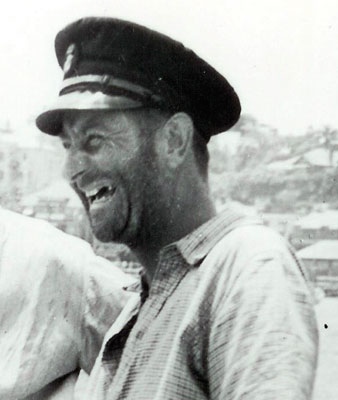
Captain John Illingworth looking more than somewhat weatherbeaten at the finish of the first Hobart race in 1945, which he won. He went on to win the Fastnet Race overall twice (in 1947 and 1949) with Myth of Malham.
Sydney–Hobart Yacht Race Start Video, Comanche Leads Fleet After Seven Hours
#rshyr – Seven hours into the 2014 Rolex Sydney Hobart Yacht Race, Jim Clark's 100-ft Maxi Comanche (USA) leads the fleet. A memorable edition of the 628-nm race appears certain, with the contest between the fleet's five Maxi yachts living up to the pre-race hype.
At 8:00pm local time, Comanche leads seven-time line honours winner Wild Oats XI by one nautical mile, with Anthony Bell's Perpetual Loyal and Syd Fischer's Ragamuffin 100 just a few miles behind the leading duo. Overnight the breeze is forecast to lighten as a high pressure system approaches. How the frontrunners navigate this transition could be a critical factor in their race.
Comanche makes mark
A fleet of 117 international yachts graced today's Rolex Sydney Hobart Yacht Race start. The thousands of spectators lining the shoreline in Sydney were treated to a dramatic start as the leading yachts powered their way out of Sydney Harbour and began the famous 628-nautical mile offshore race to Hobart.
Celebrations for the 70th edition of the race commenced with a Parade of Sail of historic Rolex Sydney Hobart competitors before the race start. A fitting tribute to the race, which has become an international icon since its inauguration in 1945.
Comanche had an incredible start reaching the first course mark at record speed. Race record holder Wild Oats XI gallantly tried to keep pace, watching in awe as Comanche laid down an early indicator of her potential. "Look at that thing go!," screamed Wild Oats XI skipper Mark Richards.
"We couldn't be more ready at this stage," admitted Comanche skipper Ken Read shortly before the race start. "The team has done a Herculean effort to get the boat ready. We are here to compete, it's the fun part of our job."
"Going into a southerly the first night is always a bit of a challenge," said Mark Richards going into the race. "(The boat) being ten years old though is a little bit of an advantage for us as we know the boat very well."
Shortly after the start, Peter Isler, navigator on Manouch Moshayedi's RIO 100 reported: "We are definitely learning our boat in these conditions. It's very rough, sailing upwind in 25-27 knots, pounding hard into short, steep waves."
The rough conditions have proved demanding for a number of the fleet with four retirements already recorded.
The race record for leading yachts to beat is 1 day, 18 hours, 23 minutes and 12 seconds, set by Bob Oatley's Wild Oats XI in 2012.
Super Maxi 'Comanche' Sets Sydney–Hobart Yacht Race Pace
#rshyrc – Super maxi Comanche lived up to all the hype today when she lead the Rolex Sydney Hobart fleet out of the Harbour in one of the most spectacular, high speed starts in the race's history.
Designed for fast broad reaching, the 15 knot plus south-easterly breeze on the harbour was made to order for the big red and black hulled yacht owned by American Jim Clark and his Australian wife, Kristy. After a brilliant start slightly ahead and to leeward of Wild Oats XI, Comanche swiftly unfurled her giant spinnaker and took off, quickly 'rolling the Oats', causing skipper Mark Richards to exclaim from the wheel of Wild Oats XI "She's smoking – look at that thing go."
As they raced down the harbour, Comanche, skippered by Ken Read, steadily widened the gap. In around five minutes they were rounding the first mark with Bob Oatley's Wild Oats XI more than 30 seconds behind her. Then came Syd Fischer's newly hulled Ragamuffin 100 and Anthony Bell's Perpetual Loyal.
The sleigh ride was over. Down came the spinnakers, Wild Oats XI and Ragamuffin quickly reefed their giant mainsails, while Comanche just kept going as the frontrunners began to beat their way out to the seamark in a lumpy, uncomfortable sea that was fast being churned into full washing machine mode as the spectator boats cluttered around them.
With their sails hardened up, WildOats XI hung onto Comanche's coattails as they clawed their way to the mark. Just ten minutes into the race, the American passed the yellow buoy. There are no records, but unofficially no boat has left Sydney Harbour more quickly in the Cruising Yacht Club of Australia's 628 nautical mile race.
The two leading boats continued beating out to sea, as did the third placed Ragamuffin 100, but startlingly, Perpetual Loyal tacked around the mark and charged through the spectator fleet towards the cliffs at South Head, tacking again under the Macquarie Lighthouse to head offshore in slightly cleaner water as most of the spectator fleet followed Comanche and WildOats XI.Next out to sea were the V70s Blackjack and Giacomo, already engaged in a fierce one on one duel that will not end until the reach Hobart, followed by Manouch Moshayedi's Rio 100.
Stunning stuff! Sydney's The Goat stacking the rail! #RSHYR pic.twitter.com/wslT1Gxwan
— Rolex Sydney Hobart (@rshyr) December 26, 2014And behind them the remainder of this 117 strong fleet paraded between the Heads in a remarkably tight line, every single boat enjoying this amazingly swift start. Well placed were Ichi Ban, OneSails Racing and last year's winner, Victoire. And one of the big unknown quantities in this race, the Botin 65 racer/cruiser Caro from the Cayman Islands has shown a very good turn of speed. Watch this space indeed.
Even Sean Langman's 82 year old gaffer Maluka of Kermandie, the oldest and smallest boat in the fleet, had rounded the first mark inside 30 minutes. An unheard of time for the little 9 metre veteran that may, or then again may not, arrive in Hobart in time for New Year.
Sadly, not long after the start, two yachts were forced to retire: Tina of Melbourne with hull damage and Bear Necessity with a damaged rudder. Both are returning to Sydney.



























